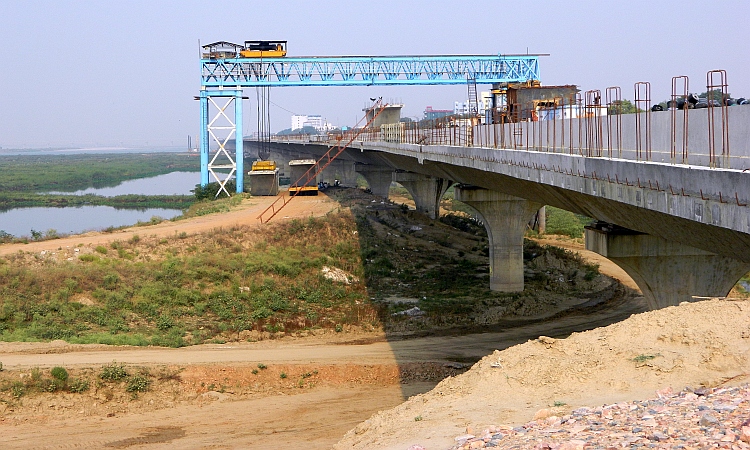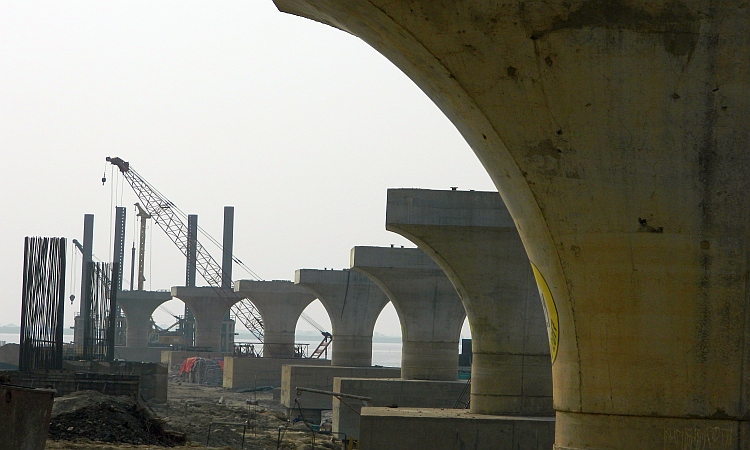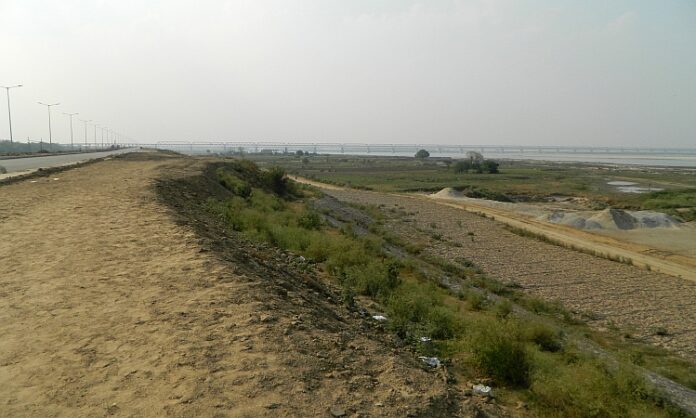Patna: In 1999, then chief minister of Bihar Lalu Prasad went against the dynamics of hydrology and had ordered the water resources department (WRD) to make all out efforts to bring the stream of river Ganga back to its southern bank.
More than two decades later, his son and deputy chief minister Tejashwi Prasad Yadav has planned raising concrete structures in the form of roadside amenities by reclaiming land in the riverbed that, engineers fear, would to push Ganga further away.
Recently, the road construction department (RCD) and urban development and housing department (UDHD), both being headed as minister by Tejashwi, have proposed to reclaim around 5,000 square metre land in the north of Ganga Pathway to develop roadside amenities in 6km length from Digha to AN Sinha institute. The amenities proposed to be built include multi-level parking, theme park, shopping complex, stadium, convention centre, etc, in the north of Loknayak Ganga Path.
Also Read: Ganga Pathway fails in first shower test, traffic blocked for repair
The Bihar State Road Development Corporation (BSRDC), a construction wing of the RCD, has come out with advertisements in various newspapers on February 20 to finalise the consultant to prepare the master plan and structural design of the proposed construction. “The layouts of roadside urban amenities would be finalised by the consultant as the master plan,” said an engineer of RCD familiar with the matter.
River basin experts, however, fear that the buildings, proposed to come up on the mounds of soil, would badly damage the natural ecosystem of the Ganga. “It would not only hamper the interconnectivity of groundwater and the river Ganga, but would also force the river to change its course and go further away from the capital city,” said professor of water resources, National Institute of Technology (NIT), Patna, Ramakar Jha, adding that river morphology has already been affected badly due to construction of JP Setu and Ganga Pathway.

Various studies carried out by the Bihar State Pollution Control Board (BSPCB) in the past suggest that quantum of flow of water in the river Ganga is declining over the years and the level of pollutants is going up notwithstanding the claims of checking flow of untreated water. “Decreasing flow of water and increasing pollution have already taken a massive toll on aquatic fauna of the river. Many water species have either disappeared or are on the verge of it,” said the researcher, preferring anonymity.
Also Read: NMCG clears sewer infra plans worth ₹2,700cr for Ganga basin
Officials said that a comprehensive plan for development of roadside amenities and beautification of riverfront were discussed and approved at a meeting chaired by deputy chief minister Tejashwi Prasad Yadav in which additional chief secretary, RCD, Pratyay Amrit was also present. It was also decided that the UDHD would develop certain structures under the smart city project. Yadav is the minister of RCD as well as the UDHD. “We will decide on the funding arrangement for fresh infrastructure once the detailed project report (DPR) is finalised,” said a senior officer of the BSRDC.
A recently retired officer of the BSRDC, however, said that he had objected to the plan of reclaiming land in the river’s bed when he was in service. He also feared that the proposal to raise concrete structure might face some serious hurdles, as it might required clearances from the Ganga River Basin Authority, state environmental impact assessment authority (SEIAA) and the Inland waterways authority of India (IWAI). “This stretch of Ganga happens to serve as the national waterways as well,” said the retired engineer.

Recalling how Lalu Prasad was desperate to restore the original course of Ganga, a former water resources department (WRD) engineer said that the department had carried out a scientific study to ascertain how the course of the river could be changed from Digha to Bihar College of Engineering (currently the NIT). Though the engineers dubbed it an exercise in futility, the WRD had proposed to create 7 feet deep and 20 feet wide channel in the silt along the southern bank to let a stream of Ganga flow.
Also Read: 35% wetlands have disappeared since 1970, says expert
The WRD went ahead with its proposal and created the channel, which saw a stream of the river flowing through the channel, when the level of Ganga went up. However, the heavy silt flowing with the water used to fill up the channel during every flood. “Lalu Prasad was in fact a great visionary. By trying to keep Ganga flowing from the southern bank, he must have thought that the river remain less aggressive on the northern banks of Saran and Vaishali district, which don’t have any embankment like the one Patna has. Water spread up to Muzaffarpur in the north when Ganga comes in spate as there was no embankment that side,” said a retired engineer, adding that Raghopur diara had to suffer after construction of JP Setu, which deflected the river’s direction further northward.
The retired engineer said that the latest bid of BSRDC might also go against the spirit of a Patna high court’s judgement in 2015, when the court had directed the Central and the state government to bring Ganga back in its natural course along its southern bank. The court had given this order after the river drifted northward from Digha owing to illegal sand mining, mushrooming of brick-kilns. The water resources department had dredged 15-metre wide canal to ensure flow of a stream of the river during the summer.
Also Read: Five years on, Patna’s STPs & their network remain incomplete
According to a study by a team of researchers from the department of environment at A N College, Patna, the Ganga is shifting 0.14 kilometres away every year in Patna. The study largely blames the lack of dredging of the riverbed for the last 30 years and large-scale discharge of untreated sewage in the river. In the days when steamers used to navigate the river in the state capital, dredgers from Denmark used to dredge the riverbed before every rainy season.
According to officials, deep dredging of the trench could not be done in the channel after the IWAI refused to carry it due to heavy discharge of untreated waste, including solid waste. Regular disposal of sludge-carrying drain water has made it hard to restore the original course of the river. The ongoing construction of Ganga pathway has also proved stumbling block to dredge the channel to ensure the smooth flow of water.
Another river basin expert Dinesh Mishra, however, sounded pessimist note saying that ‘the government is chasing the glamour to cater to modern day aspirations by pulling the crowd by killing our natural bounty’. “The government is working on lopsided priority. And if this trend continues, river Ganga would not be left more than a drain of stinting water in the next few decades,” said Mishra







